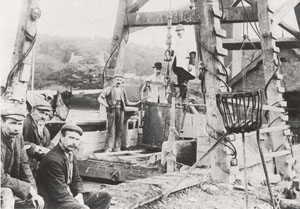
|
Mining, Quarrying & Mineral ExtractionThere are three major coalfields in Staffordshire: North Staffordshire centred on the Potteries, South Staffordshire in the “Black Country”, and Cannock Chase, the latter two converging quite closely. The coal industry in Staffordshire was developed from an early period partly because the coal seams in the Black Country were closer to the surface than anywhere else in Britain. The seams of North Staffordshire are particularly thick, if much deeper, so were not fully exploited until advancements in engineering allowed for very deep pits to be worked during the nineteenth and twentieth centuries, mainly supplying the pottery industry. In South Staffordshire the driving force for producing coal was from the iron industry. In the Black Country particularly, there was a lot of ironstone mining in order to produce iron ore. By-products from coal mining included the manufacture of coke, which was essential for blast furnaces to smelt iron. The combination of coal and iron, together with the transport links offered by the canals and railways, was a key factor in the Black County’s dominance of iron-working and to the eventual development of major engineering firms. In Staffordshire there were also many types of quarrying. The major area for sandstone used for building was in mid-eastern Staffordshire. In north and south Staffordshire, sandstone contained silica which could be extracted for the pottery industry or used for the bases of furnaces and making grinding-stones. Limestone was also used for rougher farm buildings and dry-stone walls, or otherwise burnt to produce lime for mortar or fertilisers, whilst metal ore was also extracted from the carboniferous limestone in north-eastern Staffordshire. Minerals could also be extracted. Salt was found in marlstone in central Staffordshire and gypsum or alabaster in east Staffordshire. Until the development of the canals and railways, most stone was used only locally for buildings and roads, so there were many very small quarries all over the county, often only used for a short period of time. Flooding was a significant problem in all types of mining and quarrying and pumping engines were essential to keep out the water. The work was hard and dangerous and there were many possible causes of major accidents, from floods, fires, explosions and roof collapses, as well as the more general hazards from moving machinery and carrying of heavy loads. |
